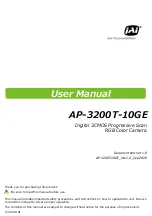
Note: When the flash head is bounced or swiveled, the power zoom control won’t work any more. The
zoom reflector returns to 50mm position, as for indirect flashing the flash coverage angle does not
match with the angle of view of the lens. Select the flash coverage angle manually by pressing the
ZOOM button.
Color Temperature and White Balance
Color Temperature of the DÖRR DCF 50 Wi is 5.400°K. The automatic white balance of digital cameras
automatically selects this color temperature. Color differences can occur with changing or mixed light.
It is therefore recommended to set the white balance manually on your digital camera. Depending on
the camera model set the white balance to 5.400°K or to flash light. Note: When taking pictures in RAW
format, the color temperature can be adjusted subsequently.
TTL Flash Control with Auto Mode
Once the flash is mounted to the camera, turn on your camera and set it to auto mode. Then turn the
flash power ON. The flash is preset to TTL flash control. “TTL” is shown on the LCD. When the flash
READY indicator lights up on the flash, you simply need to press the shutter release of your camera.
Most cameras feature a flash ready indicator also in the viewfinder. (Please refer to your camera´s
user guide.) TTL flash control ensures exact illumination of the object by controlling both the camera´s
and the flashgun´s amount of light. The flash light reflecting off the object is measured through the lens
(TTL - through the lens). When the amount of light needed for an accurate exposure has been reached,
a stop signal is passed to the flash causing the light output to be interrupted. Additionally your camera
is automatically set to the best possible aperture and exposure time. TTL flash control offers besides
high exposure accuracy and easy handling the following further advantages:
• no settings or exposure adjustments required
• extensions are automatically considered (e. g. when using extension tubes)
• filter factors e.g. of polarizing or neutral density fitlers are considered automatically
• the variable lens speed of zoom lenses is automatically considered
• the film speed in use is automatically considered
• automatic consideration of indirect flashing and diffuser plate utilization
• collects the light amount necessary for a proper exposure (TTL) only
TTL Flash Control with Aperture Priority
TTL also allows you to take shots with a focus range of your choice and aperture priority. Set your
camera to aperture priority mode (A) and the flash to TTL mode. Now you can manually set your ca-
mera to the aperture desired. Please keep in mind that by choosing a smaller aperture (larger aperture
count) the flash range will reduce. Your camera automatically controls the flash synchronization period
needed. Together with the TTL flash control it ensures correctly exposed picture results.
TTL Flash Control with Shutter Priority Mode
Set your camera to shutter priority mode (S) and the flash to TTL mode. Now you can set your camera
to an aperture and a shutter speed of your choice. However, values falling below the shortest flash
synchronization period (x-synchronization) can not be selected (most cameras automatically prevent
this). The camera´s automatic aperture function and the TTL flash control ensure correctly exposed
objects.
TTL Flash Control with Manual Exposure Setting
Set your camera to manual exposure (M) and the flash to TTL mode. Now you can set your camera to a
shutter speed of your choice. However, values falling below the shortest flash synchronization period
(x-synchronization) can not be selected (most cameras automatically prevent this). TTL flash control
ensures a proper illumination of the object despite of manual camera settings.
Manual Flash Mode Photography
Press down the MODE button 1x for manual flash mode. The LC display shows “M” followed by the
performance data. Via the MODE button you can reduce the full flash power 1/1 to 1/32 in the following
steps: 1/2, 1/4, 1/8, 1/16 and 1/32. Press down the MODE button until the desired flash performance
value is indicated on the LCD. The aperture on the camera needs to be set manually. Depending on the
aperture setting, the desired firing range can be varied. The LCD now indicates the flash range given at
a certain lens aperture setting.
Flash Synchronization
Synchronization time refers to the shutter speeds which will allow flash photography. Special
attention must be paid in the case of short shutter speeds. Each camera model features a “shortest”
synchronization - the so-called x-synchronization. Please review the user guide of your camera.
Shorter shutter speeds than the x-synchronization should under no circumstances be used in order
to avoid incorrect exposures. Using the DÖRR DCF 50 Wi with TTL mode the x-synchronization of your
camera will be set automatically.
Exposure OK Indicator
The DÖRR DCF 50 Wi features an exposure control indicator. This indicator shows you whether the
fired flash sufficiently illuminated the object or whether you should repeat the shot using a shorter
distance to the object.
11
24 mm
28 mm
35 mm
50 mm
70 mm
85 mm
105 mm
F 2,8
0,6-10,4 m
0,7-12,1 m
0,7-13,6 m
0,8-15,7 m
0,85-15,7 m
0,9-16,4 m
1,0-17,9 m
F 4
0,6-7,3 m
0,7-8,5 m
0,7-9,5 m
0,8-10,5 m
0,85-11 m
0,9-11,5 m
1,0-12,5 m
F 5,6
0,6-5,2 m
0,7-6,0 m
0,7-6,8m
0,8-7,5 m
0,85-7,9 m
0,9-8,2 m
1,0-8,9 m
F 8
0,6-3,6 m
0,7-4,3 m
0,7-4,8 m
0,8-5,3 m
0,85-5,5 m
0,9-5,8 m
1,0-6,2 m












































